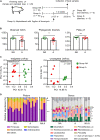Alteration of Gut Microbiota After Antibiotic Exposure in Finishing Swine
- PMID: 33643231
- PMCID: PMC7906994
- DOI: 10.3389/fmicb.2021.596002
Alteration of Gut Microbiota After Antibiotic Exposure in Finishing Swine
Abstract
Subclinical doses of antimicrobials are commonly used in the swine industry to control infectious diseases and growth performance. Accumulating evidence suggests that swine administered with antibiotics are susceptible to disease development due to disruption of the beneficial gut microbial community, which is associated with host immune regulation, nutrient digestion, and colonization resistance against pathogens. In this study, we found that finishing swine administered with lincomycin showed gut dysbiosis and increased diarrhea incidence compared with control swine. 16S rRNA amplicon sequencing was used to analyze the gut microbiota in finishing swine administered with lincomycin. The relative abundance of detrimental microbes, such as species of Clostridium, Aerococcus, Escherichia-Shigella, and Corynebacterium was increased in the feces of lincomycin-administered finishing swine, but that of bacteria associated with fiber degradation, such as species of Treponema, Succinivibrio, Fibrobacter, and Cellulosilyticum was decreased. Moreover, administration of lincomycin significantly increased the enrichment of metabolic pathways related to pathogenicity and deficiency of polysaccharide degradation. These results suggest that lincomycin treatment could cause severe disruption of the commensal microbiota in finishing swine.
Keywords: antimicrobial; fecal microbiome; gut dysfunction; meta-analysis; swine.
Copyright © 2021 Jo, Kwon, Whon, Kim, Yun, Lee, Shin, Kim and Choi.
Conflict of interest statement
The authors declare that the research was conducted in the absence of any commercial or financial relationships that could be construed as a potential conflict of interest.
Figures





Similar articles
-
Time-course alterations of gut microbiota and short-chain fatty acids after short-term lincomycin exposure in young swine.Appl Microbiol Biotechnol. 2021 Nov;105(21-22):8441-8456. doi: 10.1007/s00253-021-11627-x. Epub 2021 Oct 15. Appl Microbiol Biotechnol. 2021. PMID: 34651253
-
The Roles of Inflammation, Nutrient Availability and the Commensal Microbiota in Enteric Pathogen Infection.Microbiol Spectr. 2015 Jun;3(3). doi: 10.1128/microbiolspec.MBP-0008-2014. Microbiol Spectr. 2015. PMID: 26185088
-
Fecal metabonomics combined with 16S rRNA gene sequencing to analyze the changes of gut microbiota in rats with kidney-yang deficiency syndrome and the intervention effect of You-gui pill.J Ethnopharmacol. 2019 Nov 15;244:112139. doi: 10.1016/j.jep.2019.112139. Epub 2019 Aug 8. J Ethnopharmacol. 2019. PMID: 31401318
-
Antimicrobial Effects on Swine Gastrointestinal Microbiota and Their Accompanying Antibiotic Resistome.Front Microbiol. 2019 May 15;10:1035. doi: 10.3389/fmicb.2019.01035. eCollection 2019. Front Microbiol. 2019. PMID: 31156580 Free PMC article. Review.
-
Antimicrobial use in swine production and its effect on the swine gut microbiota and antimicrobial resistance.Can J Microbiol. 2015 Nov;61(11):785-98. doi: 10.1139/cjm-2015-0239. Epub 2015 Aug 20. Can J Microbiol. 2015. PMID: 26414105 Review.
Cited by
-
Gut microbiome perturbation and its correlation with tylosin pharmacokinetics in healthy and infected pigs.Sci Rep. 2024 Aug 12;14(1):18670. doi: 10.1038/s41598-024-69566-2. Sci Rep. 2024. PMID: 39134586 Free PMC article.
-
Changes in Serum Fatty Acid Composition and Metabolome-Microbiome Responses of Heigai Pigs Induced by Dietary N-6/n-3 Polyunsaturated Fatty Acid Ratio.Front Microbiol. 2022 Jun 22;13:917558. doi: 10.3389/fmicb.2022.917558. eCollection 2022. Front Microbiol. 2022. PMID: 35814644 Free PMC article.
-
A new approach: preventive protocols with yeast products and essential oils can reduce the in-feed use of antibiotics in growing-finishing pigs.Transl Anim Sci. 2024 Jul 13;8:txae104. doi: 10.1093/tas/txae104. eCollection 2024. Transl Anim Sci. 2024. PMID: 39185353 Free PMC article.
-
Recovery of the Structure and Function of the Pig Manure Bacterial Community after Enrofloxacin Exposure.Microbiol Spectr. 2022 Jun 29;10(3):e0200421. doi: 10.1128/spectrum.02004-21. Epub 2022 May 23. Microbiol Spectr. 2022. PMID: 35604139 Free PMC article.
-
Early-life prophylactic antibiotic treatment disturbs the stability of the gut microbiota and increases susceptibility to H9N2 AIV in chicks.Microbiome. 2023 Jul 26;11(1):163. doi: 10.1186/s40168-023-01609-8. Microbiome. 2023. PMID: 37496083 Free PMC article.
References
-
- Costa K. A., Soares A. D., Wanner S. P., Santos R., Fernandes S. O., Martins Fdos S., et al. (2014). L-arginine supplementation prevents increases in intestinal permeability and bacterial translocation in male Swiss mice subjected to physical exercise under environmental heat stress. J. Nutr. 144 218–223. 10.3945/jn.113.183186 - DOI - PubMed
LinkOut - more resources
Full Text Sources
Other Literature Sources

